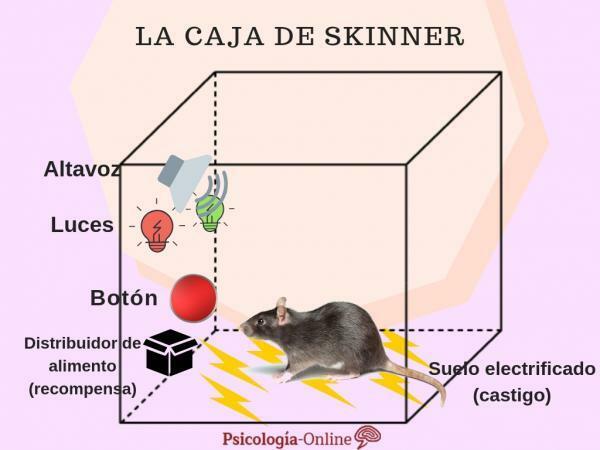
A very important aspect of Skinner's contribution is related to his passion for creating innovative technical means. In effect, he owes the idea of the so-called "Skinner box", a particular cage where the experimental animal was subjected to controlled and reproducible conditioning procedures. Its dissemination was so wide that even today its updated versions are part of the daily arsenal of those who do research in animal psychology. In this Psychology-Online article we will see together what is Skinner's box, and what does this experiment on the basis of operant conditioning consist of.
Index
- What is the Skinner box
- What is the Skinner box experiment?
- Skinner's box goal
- Skinner's box theory
- Skinner and operant conditioning
What is the Skinner box.
Skinner resumed studies of Ivan Pavlov and Edward Lee Thorndike and deepened them: Thorndike's work on learning "Instrumental" was later expanded by Skinner, who built another box, the Skinner box, very similar to the "problem box":
The improvement of the procedure and the experimental apparatus, the Skinner Box by Skinner himself, has made it possible to highlight and quantify the relationship between independent variables (discriminant stimulus and reinforcing stimulus) with the dependent variable (frequency of responses behavioral) avoiding the interference of other variables that had influenced the relationships arising from the experimental apparatus prepared by Thorndike.
What does the Skinner box experiment consist of?
Skinner's (1938) box experiment is simple: a rat was placed in a closed cage and acoustically isolated, so that the animal was not reached by external stimuli. In the cage there was a small lever whose pressure caused a ball of food to fall. The lever was also connected to an external down: when the lever was lowered, the down marked the paper that ran on a roller, thus allowing to record the frequency with which the lever. This device was called "skinner box" (Skinner box).
How does the Skinner box work? The rat in the cage, exploring the environment and moving at will, presses the lever sooner or later, causing the food ball to fall. Sometimes, it is observed that the leverage is reduced regularly. The rat presses the lever several times in a short period of time, and the intervals between the pressures coincide with the time required to eat the food ball; after which the lever is not pressed for a certain period of time, because the animal is satiated, then after a while, the rat heads resolutely to the lever, begins to press and eat.
Next, we will see the objective of Skinner's box
Target of Skinner's box.
His main interest was to understand how human behavior changes depending on the effect: if there is a pleasant consequence the subject tends to repeat the behavior. If, on the other hand, the response is unpleasant, the subject tends to abandon a behavior.
In order to study operant behaviors, Skinner introduced a variation on the problem cage used by Thorndike: the Skinner box. allowed in fact to systematically study the behaviors of animals (initially rats, then almost exclusively pigeons) under conditions controlled. Skinner's cage allows us evaluate how reinforcement acts on operational response, examining the increase in the rate with which the behavior manifests itself. His interest was not in the unconditional stimulus-conditioned stimulus association, as in the case of Pavlov, but in the possibility of modifying the frequency of occurrence of a behavior that arises spontaneously, administering a reinforcement.
In this article, you will find detailed Pavlov's dog psychological experiment.
Skinner's box theory.
It is not always possible to identify the stimulus that elicits a response, or it is not always a stimulus to elicit the response: in these cases, according to Skinner, it is the associative link established between response (behavior) and reinforcement (consequence) that determines learning and, therefore, the maintenance of behavior.
As can be seen, there is no initial stimulus that pushes the rat to press the lever: however, once the lever has been accidentally pressed, the presentation of the food reinforces the action that has determined its dosage. Learning is then "displaced" in the relationship between "action" (which Skinner and the behaviorists continue to indicate as "response") and "reinforcement", which causes this initially random behavior to be maintained by the subject.
In this article, you will find more information about skinner's theory.
Skinner and operant conditioning.
Skinner considers this paradigm a form of conditioning, and calls it "operant conditioning" to highlight the difference with Pavlov's conditioning, which is called "responder." In the latter case, the response is elicited by a stimulus and the reinforcement is correlated with the stimulus; in Skinnerian conditioning, on the contrary, it is the response that determines the reinforcement, and therefore the response is "operant", since there is no stimulus that determines it. If an operant behavior later acquires a relationship with a previous stimulation, then it can become a "discriminated operant behavior".
Here you can see the definition and examples of operant conditioning.
This article is merely informative, in Psychology-Online we do not have the power to make a diagnosis or recommend a treatment. We invite you to go to a psychologist to treat your particular case.
If you want to read more articles similar to Skinner's box: what this experiment consists of, we recommend that you enter our category of Experimental psychology.
Bibliography
- Mandolesi, L., Passafiume, D. (2004). Psychology and psychobiology of learning. Milan: Springer-Verlag.
- Petta, AM, Aragona, M. (2015). Perspectives from modern psychology. Rome: Crossing of Dialogues Association.


